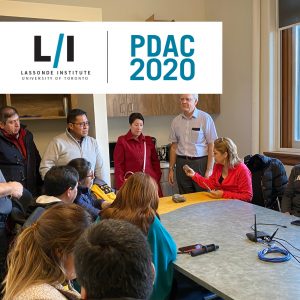
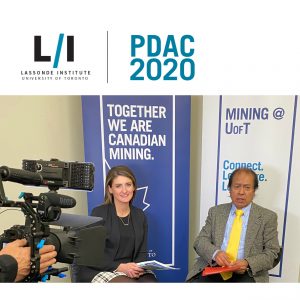


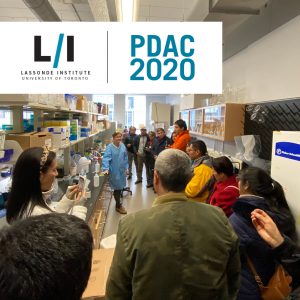
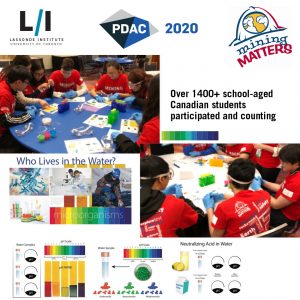
A new partnership between University of Toronto’ Lassonde Institute and Mining Matters (PDAC) launched early this year.
The educational outreach initiative created hands-on learning workshops illustrating the interconnection between water, environment and mining activities to Grades 7/8 students across the GTA.
Highlighting the importance of water quality and sustainable efforts in mining, the workshops showcase the many interdisciplinary jobs and opportunities needed to tackle the major challenges. The participants are exposed to geochemistry, microbiology and state-of-the-art genomics, the exciting world of research as well as the important environmental applications for our planet.
The partnership’s goal aims to inspire an upcoming generation to tackle global water sustainability in mining and beyond.
The workshops continue to roll out across the GTA, during PDAC and currently is being piloted in Northern Canada including First Nations communities.
Stay tuned for more details!
Lassonde Institute Director, Dr. Lesley Warren took to the stage with L/I Strategic Advisors Ian Pearce (xx) and George Hemingway (xx) with Vale’s Chief Technology Officer Afzal Jessa to discuss the pressing issues on Mining CEOs minds today.
Catalyst projects’ that bring mining companies together to solve shared problems and mitigate risk could increase industry innovation, Rachel Wallace, director of the Lassonde Institute of Mining at the University of Toronto, has told delegates at the Future of Mining Americas 2019 event in Denver, Colorado, US.
Story first appeared in Mining Magazine on October 23, 2019 (here).
Lesley Warren holds the Claudette Mackay-Lassonde Chair in Mineral Engineering and serves as the director of the Lassonde Institute of Mining at the University of Toronto.
Story first appeared on Syncrude’s Featured News Stories on March 6, 2020 (here).
As a daughter of a sailor, Lesley Warren always felt a close connection to water. But rather than following her father into the Royal Navy and exploring the briny deep, she followed her passion for water through scientific pursuits.
“My family was always linked to water because of my father, who was stationed throughout the world so we followed him. But water was always the thread,” says Lesley, who was born in England but grew up in several different ports of call. “Shortly after we emigrated to Canada when I was a teenager, I realized I could study water and wanted to pursue that. Water underpins human society.”
More than 30 years and two degrees later, Lesley is leading a team of scientists from the University of Toronto conducting critical research on Base Mine Lake, Syncrude’s demonstration project of its water-capping technology for fluid fine tailings.
“With pit lakes such as Base Mine Lake, you need to know what you are leaving in the closure landscape will seamlessly integrate with the surrounding natural environment. In order to create a healthy aquatic environment, you need oxygen,” says Lesley, an applied scientist who combines geochemistry with molecular and experimental microbiology to identify the processes that affect water quality and reclamation outcomes. “There are geo-chemical processes influenced by invisible microorganisms occurring in these systems that influence how much oxygen exists in the water. Our research aims to identify these microbially linked processes that are driving both positive and negative outcomes, so Syncrude can be smart about designing water-capped tailings technology to promote the processes that help produce oxygen.”
Lesley and her team take water samples from different depths of Base Mine Lake throughout the year to further their understanding about those processes. “Microbes live under many more conditions than we can so we sample the entire depth of the water cap to capture all the possible microbial processes that may be occurring that can influence oxygen concentrations. During the winter, this means drilling through the ice to collect samples from the water beneath. We sample the water all year to capture any seasonal changes in biological activity so we can provide a robust baseline of important oxygen-influencing processes,” says Lesley, who holds the Claudette Mackay-Lassonde Chair in Mineral Engineering and serves as the director of the Lassonde Institute of Mining at the University of Toronto.
Lesley has worked on projects at Syncrude for more than 10 years after some of the company’s researchers heard her speak on how the organization could employ microbially integrated geochemical investigation as part of its strategy to develop sound, science-based reclamation. Lesley has come to appreciate the approach taken by Syncrude.
“Syncrude has been a phenomenal partner. It values EDI (equity, diversity and inclusivity). It wants bright minds to help them find the best solutions. Syncrude is forward-thinking on so many levels. It values science and research and understands how it can propel the organization to add value and find the best solutions,” she says. “It also is not afraid to go a little further afield to find the right solutions.”
Lesley has not always experienced that same welcoming attitude during her career.
“Any female professor in any of the hard sciences has likely faced those obstacles. When I started out, maybe five per cent of the professors in the hard sciences were female. In many cases, this number has not changed in the 20 years that I have been a professor. I was fortunate to have a couple of female role models in my career,” says Lesley, who completed her undergraduate degree and PhD at U of Toronto. “That’s changing in STEM (science, technology, engineering and mathematics). I’ve certainly not experienced any barriers in the dozen or so years working at Syncrude, but that’s an organization that values inclusivity and diversity. That attitude comes straight from the top and reflects the culture of inclusivity that is embedded at Syncrude; an organization that is led currently by a female engineer.”
Lesley’s sentiments were echoed by two of her field researchers, who appreciate how much she and other female leaders in STEM have helped change the landscape for the next generation of female scientists.
“I wasn’t really aware how women were positioned in science while I was an undergrad,” says Tara Colenbrander Nelson, a water scientist who has studied and worked with Lesley since 2001. “Because I had Lesley as a mentor, I probably wasn’t as aware of some of the challenges as others in the field.”
Yunyun Yan, a PhD student who has just joined Lesley’s group this last year from China, agrees with her colleague. “The expectations for me are no different than for anybody else,” she says.
Being able to work in the field without any barriers helps produce better research, Tara says.
“There’s still a lot of science that can be learned from these projects. It’s a unique circumstance and a great place to be learning,” says Tara. “And that’s important because we work on closure projects, what happens after the mine is finished. You want the best people and brightest minds working on that so the environment is protected.”
And it’s difficult having the best people when you don’t include half of the population.
“Industry partners who want to develop the smartest strategies for these grand challenges are not going to want to limit themselves,” Lesley says. “We need to do the best we can do to steward water. I’m glad to be a part of finding those solutions because water will always be a part of who I am.”
Tara Colenbrander Nelson, a water scientist who has studied and worked with Lesley since 2001

This story first appeared on Uoft News on March 14, 2019 (here).
How do you make industrial effluent – the discharged liquid waste sitting in tailings ponds and other bodies of water – clean enough that it can be reused?
Vladimiros Papangelakis (ChemE) answered that question by treating water as a chemical.
“You have to do something to preserve, recover and reuse,” said Papangelakis, who is also the director of the Institute for Water Innovation. “To the same extent, you do similar things for all other expensive chemicals in any chemical process.
“The design is always in a way that you don’t waste your expensive chemicals.”
His forward osmosis-freeze concentration (FO-FC) hybrid process integrates the use of a spontaneous osmotic membrane step with natural freezing and simple chemicals, such as common salt, to separate and recover water from contaminated industrial effluents.
The water will likely not be drinkable after the process, he said, but it will be quite acceptable to be reused for industrial projects, which means the chemical plan won’t need to draw as much fresh water for its operations.
Forward osmosis is a process that has been refined and tested for about 10 years, using salt solutions like ammonium carbonate that decompose to gases and separate from the solution with modest heating.
Papangelakis and his research team were working with a new FO chemical invented by the Queen’s University department of chemistry. At the same time, his team was building a freezer unit simulating the effect of freezing on a Canadian lake in the north in order to produce ice to clean dirty water – when a eureka moment struck.
“The eureka moment was when we tried to combine these two things,” he explained. Instead of using a smelly, organic salt, “we found out that we could use any salt, if we combined the two processes and still be able to pull water through the membrane with minimum overall energy cost.”
In the end, the ice becomes the cleaner water that is recycled for industrial use.
“My shift (in thinking) is to the medium itself, treating water as a chemical rather than as something that is abundant and there in infinite amounts.”
Papangelakis said he believes FO-FC could have local applications in Canada taking advantage of the cold in winter, with the mining, food and oilsands industries. With the Connaught Innovation Award, his research team can begin to build an integrated prototype to demonstrate to industrial partners.
“When you compete with the entire university powerhouse – of brains and ideas – the fact that your idea is being recognized as the winning ones is a satisfying thing.”
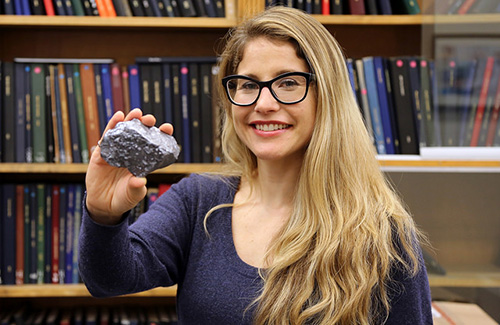
Assistant Professor Erin Bobicki wants to decrease the energy required for crushing rocks by 70 per cent (photo courtesy of Erin Bobicki)
This story first appeared on UofT News (here) by Liz Do.
Whether it’s copper for electric cars or lithium for cellphones, many everyday technologies and devices are made of or rely on metals. But mining and extracting these valuable commercial minerals can come at a catastrophic cost to the environment.
The process of comminution – crushing and grinding billions of tonnes of rocks a year – is estimated to account for more than four per cent of the world’s energy consumption. Erin Bobicki, an assistant professor in the Faculty of Applied Science & Engineering, wants to decrease the energy required for comminution by 70 per cent.
She and her collaborators in academia and industry are developing a cleaner solution using microwave technology.
“Metal is the basis of almost all the things we know and love – we need mineral processing to function as a society. Unfortunately, it’s extremely energy inefficient. If we can change that, it would make an enormous difference in mining,” says Bobicki, who has researched microwave applications in mineral processing for more than a decade.
Bobicki is leading a team to compete in the Crush It! Challenge, a competition launched by Natural Resources Canada to develop innovative solutions to reduce the energy used for crushing and grinding rocks in the mining industry. Her team, CanMicro, has just been named one of six finalists in the competition, receiving $800,000 in funding to pursue their solution.
By November 2020, the team who demonstrates the most energy savings will receive a $5 million grant to commercialize their technology.
CanMicro’s technology aims to reduce the amount of energy involved in the grinding process by exploiting the fact that valuable minerals tend to be most responsive to heat. When exposing rocks to high-powered microwaves, this variability in thermal response allows rocks that contain valuable minerals to be sorted from those that don’t.
“That means you don’t grind the ones that don’t contain anything valuable – there’s energy savings right there,” she says.
The intense blast of heat also applies stress and strain on the rocks that generates fractures across the mineral grain boundaries, which also reduces the energy required for grinding.
“We don’t have to grind it as fine because what we’re interested in has already been liberated,” says Bobicki. “Yet another opportunity for energy savings.”
The use of microwaves in the mining industry has long been considered a niche application, says Bobicki. That’s mainly because of the hurdle in developing the technology at a larger scale to handle a high tonnage of rocks.
“That’s what excites me about this project,” she says. “The objective is to scale up.”
CanMicro – which includes Professor Chris Pickles from Queen’s University as well as industry members at Kingston Process Metallurgy, Sepro Mineral Systems, COREM and the Saskatchewan Research Council – now have 18 months to test and pick the right microwave equipment before building a pilot plant in Kingston, Ont.
“I think we have a lot of risks to overcome, since this technology has never been scaled up before. But we believe that we’re going to get much better results at high power and achieve significant energy savings,” says Bobicki. “I think our chances of winning are very good.”
Beyond the competition, Bobicki is excited to see the potential of this technology one day applied, not only at a large scale, but across the mining industry.
“You can’t apply this technology to all rocks but imagine if it worked for half of the ores and we were able to reduce half of the energy required for breaking the rocks – that’s huge at a global scale,” says Bobicki.
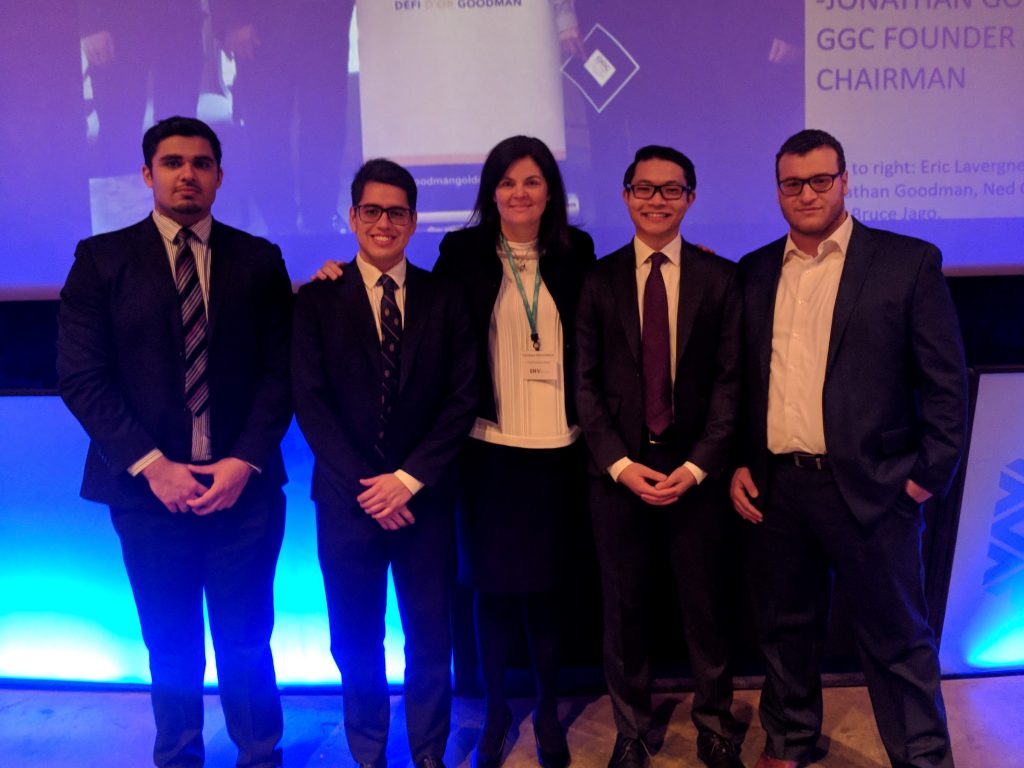
Winning Lassonde Mineral Engineering Team (Zawwar Ahmed (MinE Year 3), Dalton Veintimilla (MinE Year 4), Ice Peerawattuk (MinE Year 4) and Jihad Raya (MinE PEY)) with Candace MacGibbon, CEO of INV Metals (at centre).
This weekend, Zawwar Ahmed (MinE Year 3), Ice Peerawattuk (MinE Year 4), Jihad Raya (MinE PEY) and Dalton Veintimilla (MinE Year 4) successfully defended their first place title in the Goodman Gold Challenge (GGC) in Sudbury.
The GGC is a competition at Laurentian University that invites undergraduate students to assess three gold companies as investment opportunities. In teams of four, students recommend one of the three companies to a top-tier client.
The Lassonde Mineral Engineering team won the cash equivalent of four ounces of gold for their outstanding use of their academic and practical skills at the GGC.
Congratulations from the Department of Civil & Mineral Engineering. Keep up the good work!
That’s a wrap of #GGC2019! @MiningUofT is the team that offered the best recommendation as to which company they should invest in and wins the cash equivalent of 4 ounces of gold! Big THX to everyone involved, sponsors, participants, and guests! See you in #GGC2020! pic.twitter.com/BeAAKqxQ1D
— Goodman Gold Challenge (@ggc_lu) February 10, 2019
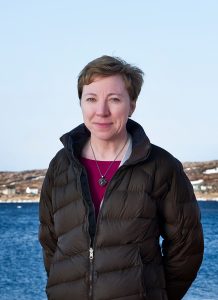
An invite-only evening with guest host Pierre Lassonde and special presentation by Zita Cobb, co-founder of the Shorefast Foundation and member of the Order of Canada.
Lessons from a dying island's economy and the woman who had the courage to re-imagine a new future.
_____________________
If you are interested in attending this event please reach out to: Director, Lassonde Institute Lesley Warren
© 2025 Faculty of Applied Science & Engineering